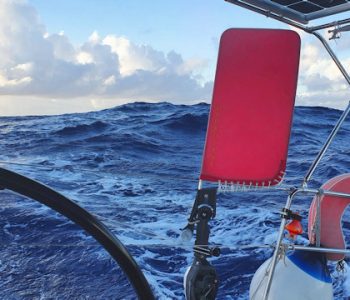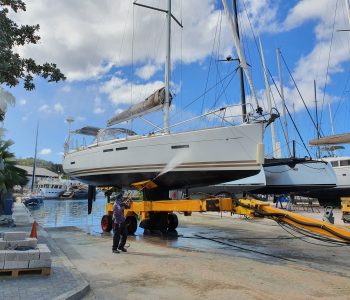 Allgemein
Allgemein
3,836 Nautical Miles to Lombok
On August 30th, I set off for Lombok with my new crew member Jakub. It is still unclear whether we will be allowed to make a stop on the route. We also don’t have a visa for Indonesia yet. However, the cyclone season clock is ticking relentlessly. So it’s time to leave.
Last Preperations
Route planning
There are almost 4,000 nautical miles ahead of us without going ashore. If Indonesia does not open within the 4 weeks and does not approve our visa applications, we will go straight to the Maldives. Then it extends the total distance to over 6,500 NM. In contrast to the first Pacific crossing from Costa Rica to Nuku Hiva , we will pass several countries and groups of islands. Route planning is therefore one of the most important preparations.
Pacific
First, we pass Vanuatu, which is about 500 NM away. Unfortunately, the request for approval for an anchor break remained unanswered after a long list of queries. So I just looked for an emergency port that we can call at in the event of an early accident. We will probably only see the next country another 1,500 NM later when we reach the Great Barrier Reef. On the way there we pass some islands that belong to Papua New Guinea. I had to take the stopover in Port Moresby, which is practical for circumnavigations, out of the planning. On the one hand, there was no response to my request here either; on the other hand, the situation in the country is quite confusing. Nevertheless, we will never be further than 300 NM from land on this part of the route.
Australia
For the entrance to the Great Barrier Reef, I have chosen 4 entrances. Which of these we ultimately use depends on the weather. Rain Island Entrance would be ideal. It offers the shortest route. From there it goes into the Torres Strait, which according to my definition separates the Pacific Ocean from the Indian Ocean. At the narrowest point, above Thursday Island, dense traffic awaits us on narrow waterways, strong currents of up to 8 knots and a choppy sea if the wind and current are in opposite directions. I was already able to experience in Kauehi how quickly the swell can change.
For a few weeks now I have been looking regularly at the weather report for these 250 NM. I was able to make an important observation. The low-pressure areas, which passed the Fiji Islands south of Australia every 14 days at least during the observation period, have a strong influence on the weather situation in the Torres Strait. On 8-10 days there is a strong south-east trade wind at its entrance, which can sometimes reach 30 knots in gusts. It pushes the Pacific into the strait with waves up to 4 meters. For the remaining 4 to 6 days, wind and swell are moderate. I would like to use this time window. In return I gladly accept that it can get a little windier on the way there. According to my extrapolation, we have to do this in the period 28.-30. Start August.
Indean Ocean
After the Torres Strait it goes about 600 NM to the west in the shallow Arafura Sea. Cape Wessel offers itself as a recovery stop and Darwin as an emergency stop. Then we have to decide whether we should accept higher waves for the stronger winds south of Timor or sail the remaining 700 NM through the Flores Sea. It’s still too early for that now.
After passing Lombok it goes a little back south to catch a stable SE trade wind, which is then called monsoon. It should carry us as far west as possible. South-southwest of the Chagos Islands we would then sail the last 600 nautical miles north to the southernmost port of entry in the Maldives. But for now we are hoping for a longer stay in Indonesia.

Last work on Aurelia
In addition to the usual vessel, safety and maneuver briefings on the Aurelia, Jakub and I had to do some maintenance work. So we spent an unplanned whole day cleaning the sewage hoses that were completely calcified after six years. The first leaks in the electric sewage pump were revealed. I would like to spare you further details of this nightmare at this point.
After a thorough inspection, I got some replacement materials that could be helpful for the remaining route to Europe. For me it is always a challenge: Where do you start, where do you stop?
Based on the experience of other sailors, I stocked up on my spare parts with hoses, hose clamps and glue. Martin from Vava U unexpectedly came to my aid for the hand pump of the bow toilet, which had also become leaky. He brought us a leftover repair kit that he no longer needed due to his conversion to electric toilets.
During the last cleaning of the Aurelia before leaving, I discovered a slightly larger grain of sand that had probably been leaking the lock for the emergency tiller for years. This tiny detail was to give me a big headache later.
Adverstisement
Jakubs second vaccination
Jakub still hasn’t had a second Covid19 vaccination. Without them there is no chance of entering Indonesia. So, I sent him on the trail with the advice that he should explain to the doctor that his vessel was going to sail and that he could only come with him if he had the second vaccination. The idea was good, but the doctor wanted to see a document. I should be able to do that. I created a professional-looking crew list, added the place of departure and time, and got us an official-looking stamp. In the second attempt it worked. Jakub’s relief was clear to see.


Provisioning
After the compulsory inventory of the food on board, which still comprised around 100 daily rations, we made a shopping list and went to the exceptionally well-stocked supermarket on the edge of the blue lane zone. We got fresh fruits and vegetables delivered to us by Farm Boy, who had transformed his business into a delivery service due to the covid-situation in Denarau.

With that the preparations were completed. Ready to go!
Departure
Covid-Test and a Good-Bye-Burger
The day of departure began with a trip to the covid test. It wouldn’t be necessary for the Maldives. But since we do not know exactly where we end up with which set of rules, we cannot avoid spending several hundred euros on this. At the same time, the end of the Fiji period ends. With the doctor visits outside the Blue Lane Zone, our permission to move between the islands will expire. Back in the marina we treated ourselves to one last burger at Sheetal. Then the time came. We cast off.
First Miles
First, we used the engine to move us out of the reef area through the Malolo Passage. Immediately behind this we set the sails first in the second reef and were happy about an amazing 6-7 knot speed. The current probably also helped a bit. Shortly afterwards the sun disappeared behind the horizon. The lights from Fiji Island became noticeably smaller.

Vanuatu
Thanks to an average speed of 5.5 knots, the journey to Vanuatu is quickly told. First, we had to get used to the cold of the night. The open sea, the occasional rain and the tiredness let us quickly get the warm clothes out of the closet. Even the oilskin wasn’t enough. I had to wear a leisure suit underneath. What is it going to be when we sail back into cooler climes?
On the first day, a gull spread between the Windex and the wind sensor. I feared it might damage something, but I couldn’t drive it away either.
After the many small flaws that I discovered on the first and second Pacific Passage, this time I decided on the 4-eyes principle. In the morning I did a control lap, in the evening it was Jakub’s turn. In the first few days we discovered loose screws on the traveler, the furler cage of the genoa and the wind vane. Another screw had passed from the stopper that prevents the mast slider from falling out of the mast. Jakub, however, found it on the deck and brought it back into position.
The gusty wind from the south not only gave us a record Etmal of 154 NM (Etmal is a common word used in Germany to describe the distance achieved within 24 hours). It also pushed us a little more north than initially planned. So we passed the archipelago north of Efate. The weather got better and better. Our solar system provided us with plenty of electricity. The autopilot and the on-board instruments could be supplied without any problems. In addition, it was sufficient for excessive cooking and for the water maker.
We reached Vanuatu in the early morning of September 3rd. So we could pass the islands in daylight. In their lee, we had to switch on the engine for the first time since Fiji. After only two hours the wind returned.
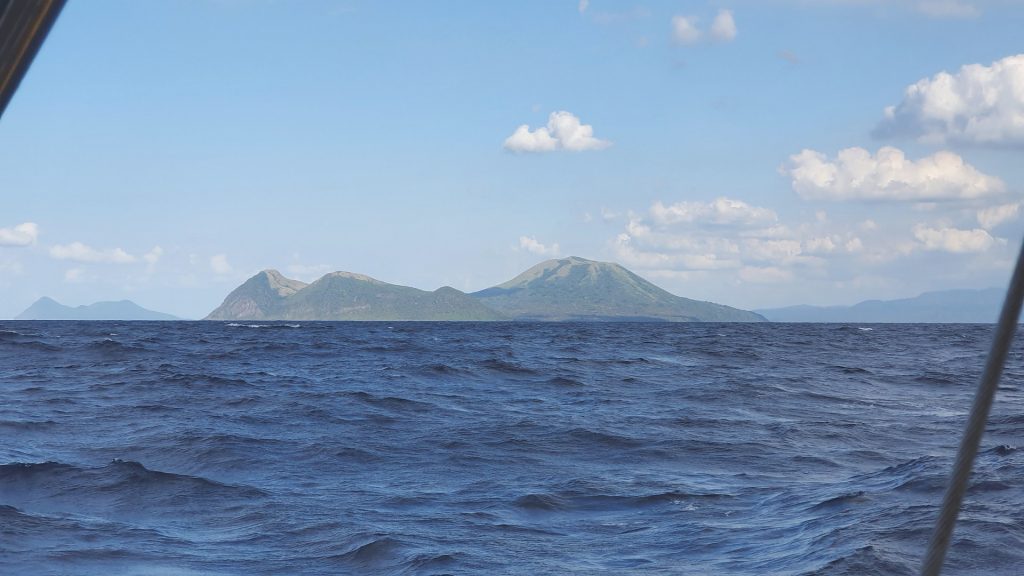

The last 1,500 NM in the open pacific
The next section with a length of 1500 nautical miles had some surprises in store for us. But first it went ahead with moderate winds and sunshine with an average of 5 kn. Jakub called the time “champagne sailing”.


During these days we only use the wind vane. Without the hydraulic autopilot, we saved more than 1 kWh per day, which we invested in generating fresh water until the tank was full to the brim. With the still excess energy, we heated our hot water boiler and were able to enjoy one or the other warm shower. We used the free time to remove the salt from the blocks and to seal the still leaking sewage pump.

Soon the calm came to an end. The weather forecast predicted gusts of up to 38 knots. So on September 7th we prepared for the stormy wind. Dinghy engine, code 0 and other unnecessary items have been removed from the cockpit and fore deck. They disappeared into the empty cabin. We also positioned the long lines at the stern in such a way that we could deploy them easily.
When I started the hydraulic autopilot again, he acknowledged it with a slight groan. The rudder began to creak too.
A potentially critical problem was revealed by hand steering. It was difficult to move the rudder. The repair options at sea are very limited for this. The lower bearing can only be reached by removing the rudder. For the upper one there is a small service hatch near the bathing platform.
A detailed search revealed several problems:
- The hydraulic cylinder has twisted again. The hydraulic oil threatened to leak. I renewed the lock with duct tape and cable ties.
- The bolt connecting the autopilot to the quadrant was again loose. However, the self-locking nut appears to have found a stable position on the thread. I won’t change anything here for the time being.
- Salt deposits could be seen on the upper rudder bearing. As mentioned at the beginning, I removed a grain of sand the last time I cleaned it. As a result, no more water flowed into the access for the emergency tiller. The salt on the upper bearing had therefore crystallized out. Is that the reason for the stiff rudder? That would be a solvable problem, but I can’t imagine it. Cleaning turned out to be difficult and initially unsuccessful.
I have to admit that the sum of the three problems made me uneasy. Trying not to transfer this to Jakub, I explained every step and every consideration with the best possible calm and objectivity. The wind had increased meanwhile. We packed the main sail into the lazy bag. We reefed the genoa so far that only a few square meters left for propulsion. Now that the birds have also sought refuge on the Aurelia, the bad weather cannot be far away.



For the next 48 hours we sailed through the rough sea up to 4 meters high with a wind of up to 36 knots. Every now and then the creaking improved but became stronger overall. The autopilot groaned under the load and acknowledged the situation with significantly higher energy consumption. To relieve him, I also used the wind vane to support the main rudder. We also deployed the tug lines, and even extended them by further 9 meters due to the longer waves.


On the afternoon of September 9th, I made a desperate attempt to solve the problem. I opened the lock for the emergency tiller and poured half a liter of water into it. I gladly accepted that the bilge pump would start. A few minutes later the creaking was gone.
I checked the wind vane routinely and froze in shock. The lower connection was only held by a screw and threatened to tear off at any moment. The second had been torn off by the pressure of the waves. I called Jakub on deck. Together we lowered the bathing platform despite the swell, removed the rudder of the wind vane and replaced the broken screw with one from the upper console. Finally, we couldn’t leave the 11mm hole just above the waterline open. With the remnants of the lower screw, I tinkered a screw connection for the newly created hole.
After several hours of hard work, during which Jacob’s life jacket also opened unplanned, the Aurelia was sealed again and the wind vane was temporarily fastened. The creaking of the rudder is gone. Was it perhaps the wind vane?
The answer came the following morning. The creak returned. I poured another half a liter of water over the upper rudder bearing. The creak disappeared again. Although the rudder is more difficult than usual, it is still sufficiently easy to move. So we have a temporary solution to this problem. For me the question remains whether this little bit of salt can cause such great difficulties. I am still skeptical whether the lower rudder bearing, which was repaired in Curacao, e.g. due to a lack of grease, is not the primary cause. We won’t find out until we get the Aurelia out of the water at the earliest. Until then, only the water solution remains.
Adverstisement
The weather improved noticeably. The swell decreased slowly but steadily. After three days of great tension, I could finally take a deep breath.
On the remaining 500 nautical miles to Australia, we used code 0 more frequently in winds of up to 16 knots. Its halyard showed surprisingly little wear and tear and did not need to be shortened yet. However, the connection between the sail and the furler broke. As a result, it slid up about 40 cm and slowly began to wrinkle. We furled it in again 200 nautical miles from the Great Barrier Reef and sailed mainly with the genoa towards the new section.
Shortly before the reef, I spotted the first sailboat since departure on the monitor. It was the 16-meter-long SV Estron. I often met the skipper in the Fiji WhatsApp group, but I never personally. The SV Estron is four meters longer than the Aurelia. This allows her to sail much faster. So she won’t be with us for long. We were very happy when we were able to establish radio contact with him. However, it was short-lived. After a few seconds of transmission, the security responsible for his radio took its leave. We switched to InReach and exchanged text messages.
The sewage pump leaked significantly less after using the adhesive, but still too much. As a final attempt, I surrounded the hard-to-reach joints with a generous portion of silicone. Apparently with success.
The 2nd time change and the exchange of the Pacific map for the Australian one were two beneficial milestones after the stressful days.
Great Barrier Reef
On the evening of September 14th, we were only about 40 nautical miles from the Raine Island Entrance. The swell was only a moderate 2 meters. The extrapolation of the tide showed that during my shift we will pass the entrance quite precisely at the high water slack tide. Perfect! That’s how I imagined it and calculated it. We passed the entrance at night without the slightest problem from the current or the swell. However, there was no trace of land the next morning either. All the areas shown on the map, some of which were falling dry, were under water.
Not surprisingly, we were greeted by an Australian Border Force (ABF) aircraft. I expected it, but not like that. With no perceptible sound, it had descended from the bow onto the Aurelia with the propellers nearly idling. Only at the last moment was a faint engine noise to be heard. Just above the mast, it revved up the engines. The plane disappeared after a few seconds behind the stern. After a few more seconds, the aircraft reported on the radio with a crystal-clear announcement: “To the white sailing vessel, which was just overflown by an ABF aircraft.” After I got in touch, we switched to another channel and I answered their questions. A little later the friendly conversation was over. The process was repeated three times over the next few days, twice without further radio contact.


Astonishingly fast it went now north-north-west. The depth varied between 15 and 30 meters. Several remoras appeared at the stern. Jakub could even spot a shark. Towards evening we reached the Adolphus Canal. If we hurry, we will also reach the point with the greatest risk of flow at the ideal time – the nocturnal flood.
However, the wind picked up. We hissed through the Adolphus Canal at 7 to 9 knots. Twice as fast as planned. I looked for cover behind Cape York and let us drift in the lee of the Cape for an hour. Jakub took over the helm. I was able to slumber a little. Real sleep was out of the question during these exciting hours.
Torres Strait
At around 2:00 a.m. we were just before the entrance to the Prince of Wales Canal. With sufficient distance to some rocks we went back to the waterway. Unfortunately, I wasn’t the only one waiting for the perfect moment. Three vessels with a length of approx. 300 meters wanted to pass it at the same time. After some radio communication it was clear to everyone what position the other vessels were taking. Then we went into the canal. At first I stayed as far west as possible so that the tanker coming from the south could overtake us on our starboard side. Shortly after passing the freighter coming in east, I entered the Prince Of Wales Canal and drove so close to the north side that I had the feeling that I could touch the eight meter high mast of the beacon there with my hand.
In fact, we were still 90 meters away. Finally, the tanker approaching from the west passed us without any problems. We passed the narrowest point exactly at the flood time. We were through! No counter-current, no choppy sea. The rest is “just” sailing in a confined space. Jakub had supported me all the time with binoculars and checked with bearings whether we were on a collision course with one of the navigation signs or vessels. I’m glad I didn’t have to go through here alone. I would only have done that during the daytime.
Exhausted and happy about the successful last 48 hours, I disappeared into my bunk. I was so tired that I even forgot that I sleep in the salon at sea.
It was only towards the end of the following day that I realized that we had only completed all maneuvers under sail. I’m pretty sure that these were the best maneuvers from planning to execution that I have managed since I started sailing. Thanks to Jakub, of course, who gave me excellent support.


Arafura Sea
Non-stop to Lombok
We passed the exit of the Gannet Passage at dawn on September 16. Booby Island is the only thing we saw of Australia on Daily List.

Still happy about the successful passage of the Great Barrier Reef and the Torres Strait, we considered whether we should call at the intended anchorage in Cape Wessel or sail non-stop to Lombok. Since the freshly fetched weather forecast predicted a large-scale and long-lasting lull, the decision was an easy one. It goes directly to Lombok.
We took a much more northerly course and overseen the Merkara shallows. We crossed the approximately one Kilometer wide area almost in the middle. Fortunately, it was sufficiently deep at 6 meters. Otherwise, I would probably have noticed it earlier. However, I only discovered them after arriving in Lombok.
The Arafura Sea is only about 50 meters deep in the east. The sea shimmers turquoise to the horizon. A sight that I have never seen before. This turquoise was only seen in Curacao – but only in the bays.

Over the next few days the wind was blowing at 16 to 20 knots in almost ideal strength and direction. Only on the first and second day there were gusts of up to 27 knots. The Aurelia rewarded this with an average speed of almost 6 knots for days.
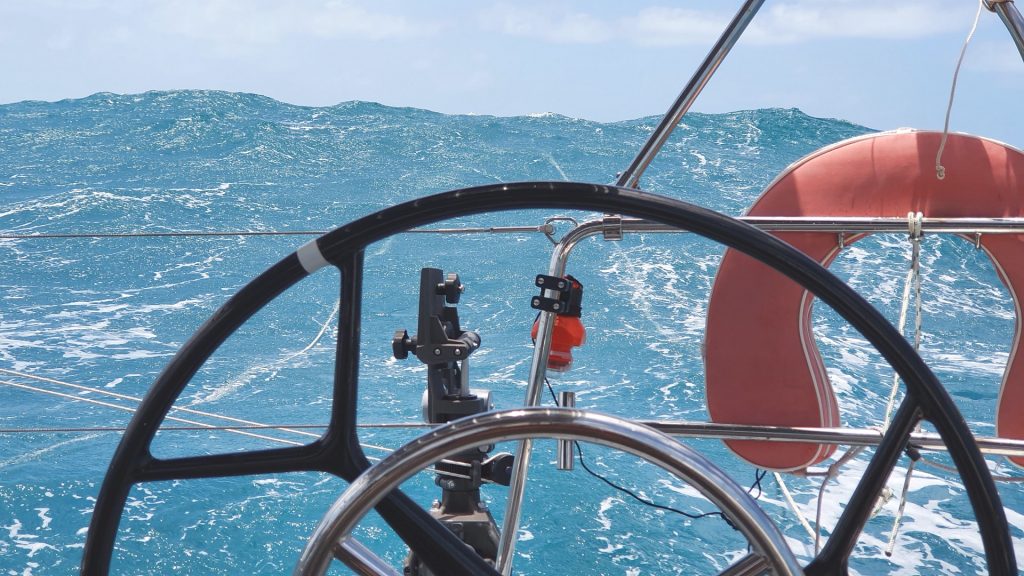
Illegal driftnet?
On the first night we had an unusual encounter. In the middle of my night shift, numerous AIS signals suddenly appeared. They were not marked as buoys, but as vessels with constantly changing directions. The vessel names also changed. Voltage and level information was coded into them. I tried in vain to make radio contact. Since the signals came from all directions and did not reveal any pattern, I was unable to make a meaningful decision to change course.
At dawn it happened: a few meters from the Aurelia, a fishing net appeared just below the surface of the water. None as you know it from the coast. The top line was at least as thick as a thumb. Every 30 cm it was provided with a fluorescent float. It was far too late to evade. There was only time to strive for a right angle to the network, then I already felt a delay. We hit this extremely stable net with our keel. Slowly it rolled lower and snapped backwards after it passed its lower edge.
Aurelia’s keel goes deeper than the rudder and much deeper than the propeller. Hence, there seems to have been no harm. With a catamaran without a keel, I would now have a big problem. A rudder bearing that has broken out of the hull can quickly lead to the sinking.
We are now probably within a gigantic driftnet of unknown origin. The process was repeated an hour later. We have evidently escaped the net again.


Even if this type of fishing did not affect me myself, I would find it abnormal and disregarding nature. Without clear labeling and radio contact, it also poses a serious risk to traffic. Even as a computer scientist, my hair stands on end when dynamic device attributes such as voltage and fill level are encoded into static fields with a completely different meaning.
It was the third night in a row that I barely slept. On September 17th, Jakub’s birthday, I had just enough energy to bake a few birthday cookies. The first two for him, the other two disappeared unbaked in the sink drain thanks to an unexpected wave from the side.
In the next few days things went on quickly and without any further problems. Only the base plate for the blocks around the mast began to creak. A check of the screw connections to the deck showed that everything appears to be in order. Here, too, a bucket of water brought the solution. Crystallized salt between the base plate and the GRP of the deck had created the noise.
Fishing
During our journey through the Arafura Sea, we brought out our fishing lines as soon as the long lines were not in use. On September 19th we caught a black fin tuna. Funnily enough, the indicator on the port fishing line alerted us while the fish was on the starboard line. He was on board quickly. Jakub cleaned and turned it into two extremely tasty meals.
A few days later we caught another catch at almost the same time. This time it was a Real Bonito, also called a skipjack. It was about the same weight and thus provided two more meals.



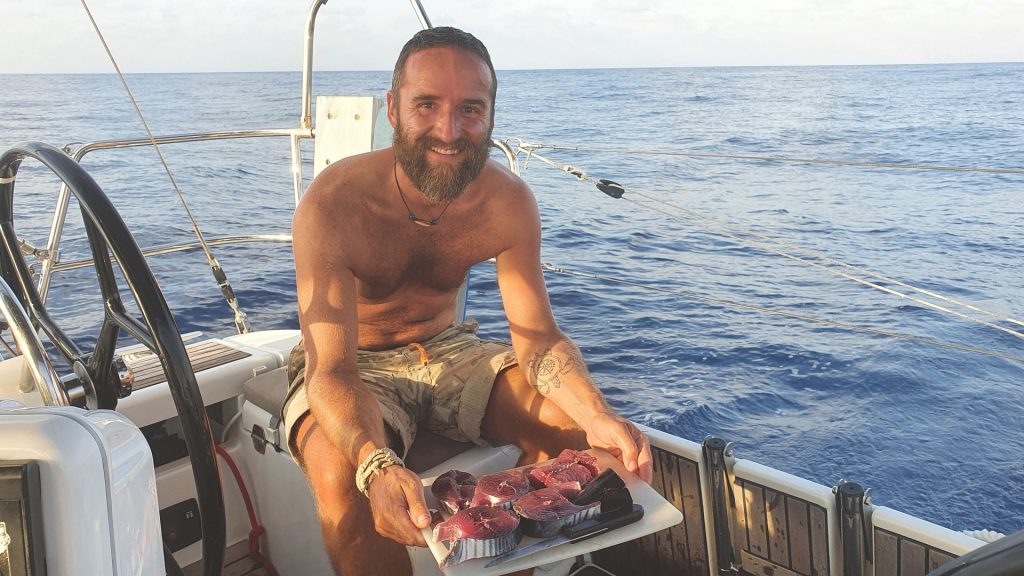
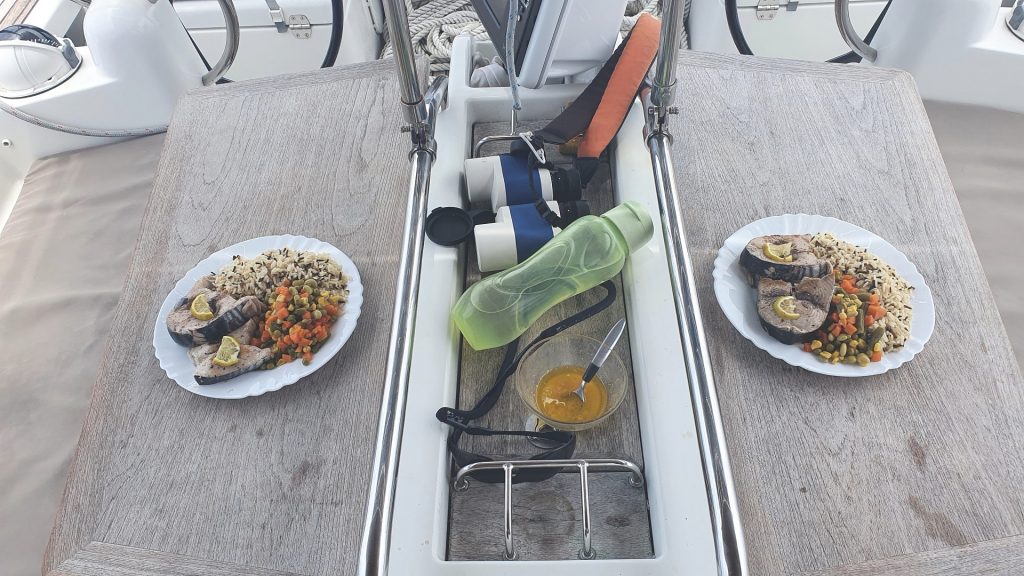
Timor- oder Flores-See?
After the encounter with the driftnet, I was glad that we came into the Australian economic zone again. The risk of encountering illegal fishing is significantly lower here. Another ABF plane visited us. It flew low over us twice. Another radio contact went much more quickly. We were already on the list.
On the night of September 21, we came pretty close to the first Indonesian island of Yamdena. During his shift, Jakub had allowed himself to be pushed quite close to it due to the freshening wind. It continued to freshen up on my shift, so I struggled staying in international waters without making any nightly setup changes. Finally, I managed to stay about 15 nautical miles south of the island at an average of 7 knots.
In keeping with the rush ride, the sun gave us an extraordinary sunrise.

The next day we had to decide: do we sail north into the well-protected Flores Sea or do we make a southerly course around Timor and head for Lombok from below? According to the weather report, we expect weak winds in both areas. In the Flores Sea, however, much later. We may then be within engine range of Lombok. So I decided on this route. It also leads closer to land. In case our rudder problems worsen, this is also the safer way to go.
Flores-Sea
Just 24 hours later we found ourselves in the Flores Sea. Wind, currents and swell gave us a good Etmal of 140 NM during the entry. Now we passed one island after the other. Almost alone on the sea during the day, we encountered numerous fishing boats at night. Most of them had AIS and had correct lighting. Unfortunately not all of them.
With the emergency and call channel 16 the Indonesian fishers have little fear of contact. There was intense radio communication, sometimes singing. Every now and then the voices sounded a bit slurred, but since I am not familiar with the language, I do not want to assume excessive alcohol consumption here.
Some freighters and tankers on their way to or from Singapore also chose this route. One of them answered the chatter with “If you want to continue to abuse the emergency call channel, look for another planet”. That brought calm for a while.

Piracy Warning
I made radio contact with one of the tankers. I wanted to check the functionality of my AIS again. However, that was more of an excuse. In truth, I enjoyed the contact with the outside world. After he had confirmed my visibility, we briefly talked about our goals on another channel.
The radio operator warned me about pirates. When I asked for more details, he replied that they were everywhere. The concern is not entirely unfounded, but after my last research it is exaggerated. However, it was not without effect. A feeling of insecurity spread inside me. My opposite noticed just in time what he had done. He turned the conversation in a more fun direction and asked me if we were the pirates. In the end, he reassured me with excellent weather prospects. To be on the safe side, I’ll read through the latest piracy news as soon as I’m in Lombok.

Doldrum
On the morning of September 25th, we caught the first doldrum. There are still more than 500 nautical miles to Lombok. Too far to reach our destination with the engine. By and large, however, our plan worked out. We had decided on the right route with the Flores Sea.
With frequent changes between sailing and engine operation, we fought our way west. On September 29th at 10:30 am I discovered the land of Lombok for the first time. The 3700 meter high Rinjani volcano showed its peak above the clouds. That is amazing, there are still 100 nautical miles to the destination.

After more than 4 weeks at sea, our anticipation for the arrival increased by the hour. However, we still had to concentrate on the journey. Not every vessel has AIS. The smaller ones are sometimes without and at night without lights. In addition, the rubbish and debris in the sea was constantly increasing.
New Engine Problems?
Before the first night we had to run the engine due to the doldrums, I took a routine look in the engine compartment. As always, everything below him was dry and clean. But a lonely nut rolled on in the motor bilge. Unimportant nuts on an engine are very unlikely. So I overcame my tiredness and went looking. About an hour later, I found the screw that was missing it. It had slipped so far that it was barely recognizable. It fixes the tension arm for the V-belt. If it falls out, the next V-belt would burst. That would certainly have happened within the next few hours. So: engine off, loosen V-belt, attach locking nut, tension V-belt, engine on. I’ve got a routine in it now. A little later we stomped towards Lombok again.
Whales
Around noon – Jakub was standing in the pantry – I discovered two water fountains on the port side. Must be whales. I kept shouting “Whales, whales!” until Jakub was on deck. Then we pulled out our cameras and documented the rare and impressive spectacle. I would have liked to have watched them a little closer. On the other hand, after all the reports of killer whale rudder damages, I’m glad they kept a safe distance.
I estimate their length to be 10 to 15 meters. Based on the dorsal fin, we suspect that they were two sperm whales.
Final spurt along the Lombok Strait
In the afternoon I mentioned to Jakub that the next 24 hours can be exhausting again. According to the weather report, gusts of up to 25 knots are expected north of the Lombok Strait. Since we are sailing south-west first and then straight south, this means beating over the last 50 miles. In addition, there is dense traffic, currents running against the wind and shallows.

The reality was much better, however. We motored all night with little wind. More and more freighters and tankers appeared on the plotter. Like a string of pearls, they pulled their train through Lombok Street. Only at dawn did the wind pick up. We set sail and sailed upwind between land and waterway towards our goal.
A turning angle of well below 90 ° put a smile on my face. This is an excellent value and shortens the remaining distance considerably. That we achieved this despite the 1st reef, I would like to attribute to my sailing skills. In truth, however, it is due to the northerly current. So I can at least attach a navigation bee to my revert.
As the sun rose higher, small sailing boats began to appear more and more frequently. The typical Indonesian outrigger boats look like big spiders from a distance. Only when you take a closer look you can see the outriggers. Most of the boats called “Jukung” were sailing with crab claw sails. The rest either used modern outboards or rattling single cylinders with an external propeller shaft.



In total there were over 50 of these boats that crossed our course. Most of the time I was behind the wheel while Jakub kept an eye out with the binoculars to see if we had a stationary bearing for one of the boats and were thus on a collision course. Several times I had to evade and make one or two additional turns. Even if we were a little exhausted after the long tour, I had a lot of fun on this final spurt.
Arrival
We hid the sails three miles from the marina, closed the lazy-bag and prepared to tie on a mooring buoy. We had to be careful one last time. Between the hard-to-see blue buoys of the fishing nets and the still numerous Jukungs, there was little room for the Aurelia. Eventually we discovered the Ohana and Sherley’s Speedwell of Hong. Both were in front of the Marina Del Ray. We drove past them and greeted the crews.
At 1:30 p.m., after 3,836 nautical miles, 4 weeks, 3 days and 4 hours, we tied to a free buoy. More relieved than exhausted, we treated ourselves to a first berthing cocktail.





